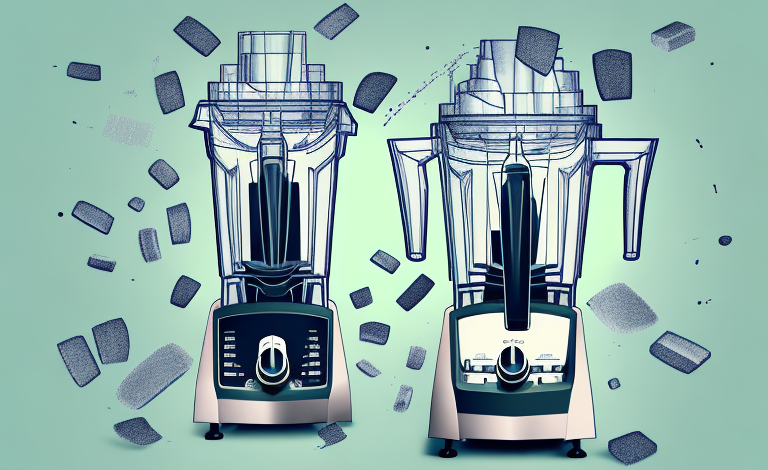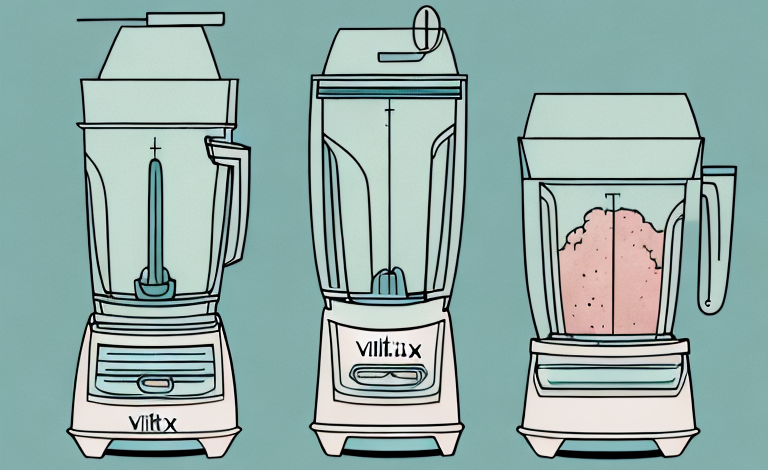There has been a lot of debate in the health and nutrition world about the benefits of using a Vitamix blender, and one of the most common questions is whether it can break down the cell walls of fruits and vegetables. In this article, we will explore the science behind cell walls and their role in human nutrition, and discuss how Vitamix blenders can benefit your health.
Understanding the mechanics of cell walls
Before we can answer the question of whether Vitamix can break down cell walls, it’s important to understand what a cell wall is and how it works. Simply put, cell walls are the outer layer of cells in plants and other organisms that provides structure and support to the cell. They consist mainly of complex carbohydrates called cellulose, which can be difficult for our bodies to break down and digest.
The thickness and strength of cell walls varies depending on the type of plant or organism, as well as other factors such as age and growing conditions. Some plants, like leafy greens and soft fruits, have relatively thin and fragile cell walls, while others, like root vegetables and grains, have tougher, more resilient walls.
Cell walls also play a crucial role in protecting plants from external threats such as pests and diseases. The tough outer layer can act as a barrier, preventing harmful substances from entering the cell and causing damage. In addition, cell walls can also help regulate the movement of water and nutrients within the plant, ensuring that it receives the necessary resources for growth and survival.
However, despite their importance, cell walls can also pose a challenge when it comes to extracting nutrients from plant-based foods. While some nutrients are easily accessible, others may be trapped within the tough cell walls, making them difficult to access and absorb. This is where high-powered blenders like Vitamix come in, as they are able to break down the cell walls and release the nutrients within, making them more readily available for our bodies to use.
The role of cell walls in human nutrition
So, why do we care about cell walls in human nutrition? It turns out that these tough, fibrous structures play a crucial role in our digestive health. When we eat plants, our bodies need to break down the cell walls in order to access the nutrients inside the cells. The process of breaking down cell walls, called cell wall digestion, is essential for extracting vitamins, minerals, and other important compounds from plant-based foods.
However, because cellulose is so difficult to break down, we need a little help from enzymes and other digestive aids to fully digest plant-based foods. That’s where Vitamix blenders come in.
Another important aspect of cell walls in human nutrition is their role in promoting satiety. Because cell walls are indigestible, they add bulk to our food without adding calories. This means that foods high in fiber, which is found in cell walls, can help us feel full and satisfied after eating, which can lead to better weight management and overall health.
Additionally, some research suggests that the type of fiber found in cell walls, known as soluble fiber, may help lower cholesterol levels and reduce the risk of heart disease. Soluble fiber forms a gel-like substance in the digestive tract, which can bind to cholesterol and prevent it from being absorbed into the bloodstream.
How Vitamix can benefit your health
One of the most unique features of Vitamix blenders is their powerful motor and sharp blades, which are specifically designed to break down cell walls and release the nutrients inside. When you use a Vitamix to make a smoothie or other blended dish, the high-speed rotation of the blades creates a vortex that pulls food down towards the blades, where they are pulverized into a smooth, creamy texture.
Because Vitamix blenders are able to break down cell walls more efficiently than other blenders, they can help your body to extract more nutrients from plant-based foods. This can lead to a wide range of health benefits, including improved digestion, increased energy, and better overall nutrition.
In addition to the benefits of extracting more nutrients from plant-based foods, using a Vitamix can also help you incorporate more fruits and vegetables into your diet. By blending them into a smoothie or soup, you can easily consume multiple servings of produce in one meal. This can help you meet your daily recommended intake of vitamins, minerals, and fiber, which can support a healthy immune system, reduce inflammation, and lower your risk of chronic diseases such as heart disease and cancer.
The science behind Vitamix and its effects on food
Our bodies aren’t the only things that benefit from the powerful blades of a Vitamix blender. A number of studies have investigated the effects of blending on the nutritional content of fruits and vegetables, and the results are intriguing.
For example, one study published in the Journal of Agricultural and Food Chemistry found that blending certain vegetables like carrots and sweet potatoes actually increased the bioavailability of certain nutrients, such as beta-carotene, compared to unblended vegetables. Other studies have found that blending can help to increase the antioxidant content of fruits and vegetables, and may even help to break down some of the anti-nutrients that can interfere with nutrient absorption.
In addition to the nutritional benefits, using a Vitamix blender can also make it easier to consume a wider variety of fruits and vegetables. Blending allows you to mix different types of produce together, creating unique flavor combinations that can make healthy foods more enjoyable to eat. This can be especially helpful for those who struggle to eat enough fruits and vegetables on a daily basis.
Furthermore, using a Vitamix blender can also help to reduce food waste. By blending fruits and vegetables that may be slightly past their prime, you can still use them in a delicious and nutritious way, rather than throwing them away. This can be a great way to save money and reduce your environmental impact.
Exploring the different types of Vitamix blenders and their capabilities
Of course, not all Vitamix blenders are created equal. There are a wide range of models available, each with their own unique features and capabilities. Some of the more powerful models, like the Vitamix 750 or the Vitamix A3500, are able to handle even the toughest, most fibrous plant-based foods with ease, while other models may struggle with harder vegetables and grains.
If you’re serious about using your Vitamix for cell wall digestion, it’s important to choose a model that has a powerful motor and sharp blades that can handle the toughest foods. Look for models with at least 2 horsepower and a high blade speed, as well as tamper tools that can help you blend even the thickest, most stubborn ingredients.
Another important factor to consider when choosing a Vitamix blender is the size and capacity of the container. Some models come with smaller containers, which may be more suitable for single servings or smaller batches, while others have larger containers that can handle larger quantities of ingredients. It’s important to choose a container size that fits your needs and the types of recipes you plan on making.
Additionally, some Vitamix blenders come with pre-programmed settings for specific recipes, such as smoothies, soups, or nut butters. These settings can make it easier to achieve the perfect consistency and texture for your desired recipe, without having to manually adjust the speed and time. If you plan on making a lot of specific recipes, it may be worth investing in a model with pre-programmed settings.
Vitamix vs other blenders: a comparison of breaking down cell walls
Of course, Vitamix isn’t the only blender on the market that can break down cell walls. There are a number of other high-powered blenders available, such as the Blendtec, the Nutribullet, and the Breville Boss, that are designed for similar purposes.
However, many experts and consumers agree that Vitamix blenders are among the best options for cell wall digestion. One reason for this is their unique tamper tool, which allows you to push down stubborn ingredients and keep them circulating in the blades. Additionally, Vitamix has a reputation for durability and longevity, meaning that your blender is likely to last for many years with proper care and maintenance.
Another advantage of Vitamix blenders is their versatility. They can be used for a wide range of tasks, from making smoothies and soups to grinding nuts and seeds. This means that you can get more use out of your Vitamix than you might with a blender that is designed for a specific purpose.
Finally, Vitamix blenders are known for their powerful motors, which can handle even the toughest ingredients. This means that you can blend large quantities of ingredients at once, without worrying about burning out the motor or damaging the blades. Overall, if you’re looking for a blender that can break down cell walls and handle a variety of tasks, a Vitamix is definitely worth considering.
Does blending destroy nutrients? Debunking common myths about Vitamix
There are some who argue that blending, including with a Vitamix, can actually destroy nutrients in fruits and veggies. While it’s true that some nutrients can be lost during processing, such as vitamin C or certain B vitamins, the overall benefits of blending often outweigh any potential downsides.
For one, blending can help to make nutrients more bioavailable, meaning that your body is better able to absorb and use them. Additionally, the benefits of getting more fruits and vegetables into your diet generally outweigh any small losses in nutrient content.
Tips for maximizing nutrient absorption with your Vitamix blender
So, now that you know why Vitamix blenders are so great for cell wall digestion, how can you be sure you’re getting the most out of your blender? Here are a few tips for maximizing nutrient absorption:
- Use a variety of different fruits and vegetables to get a broad range of nutrients.
- Include healthy fats, such as avocado or nut butters, to help your body absorb fat-soluble vitamins like vitamins A, D, E, and K.
- Add in some protein, such as Greek yogurt or tofu, to make your smoothie more filling and balanced.
- Blend your smoothies for at least 30-60 seconds to ensure a smooth, creamy texture.
- Experiment with different ingredients and recipes to find what works best for your taste and dietary needs.
Recipes to try with your Vitamix blender for optimal nutrient intake
If you’re looking for some inspiration to get started with your Vitamix blender, here are a few nutrient-rich recipes to try:
- Green smoothie: blend together a handful of spinach or other leafy greens, 1/2 a banana, 1/2 an avocado, a scoop of protein powder, and a cup of almond milk for a delicious and nutritious breakfast.
- Roasted vegetable soup: blend together roasted vegetables like carrots, sweet potatoes, and zucchini with vegetable broth and spices for a warming and satisfying meal.
- Chia seed pudding: blend together coconut milk, chia seeds, vanilla extract, and a touch of honey or maple syrup for a healthy and delicious dessert.
Conclusion
So, does Vitamix break down cell walls? Yes, it does – and in doing so, it can help to unlock a wide range of health benefits. Whether you’re looking to improve your digestion, increase your energy levels, or just get more nutrients into your diet, a Vitamix blender can be an essential tool for achieving your health goals.



